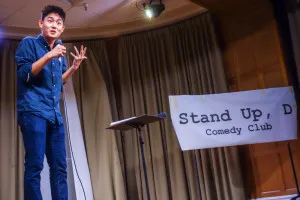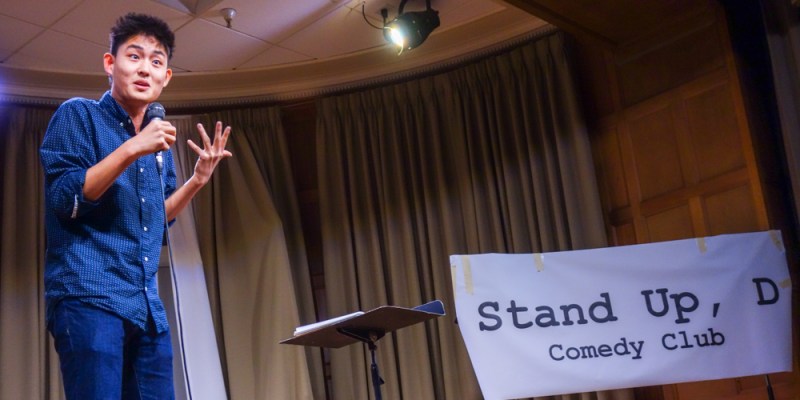
The format for tonight’s show is simple, says Stu Melton ‘15. The co-president of Stanford’s comedy club Stand Up, D — and tonight’s co-host — faces a full Roble theater. The audience is relaxed and ready for laughs.
“I’ll start with a joke,” he says. “I’ll continue with some more jokes. And then I’ll finish on a joke.”
As lecturer Hilton Obenzinger Ph.D. ‘97 said, “The first duty of a stand-up comic is to make people laugh.”
Obenzinger teaches the class “Stand-Up Comedy and the ‘Great American Joke’ Since 1945” in autumn quarter.
“If you can laugh at something, you’re bringing it close, making it real. You can’t be in awe or afraid of something if you can laugh at it,” he said.
Obenzinger cited comedian Tig Notaros’ visit to Stanford last week. One of the first jokes she told was about breast cancer.
“People were very conflicted,” Obenzinger said. The joke grew, as did the audience’s comfort, allowing them to laugh along with Notaro.
But laughter, which makes comedy so successful, can also be its downfall.
“People don’t think that laughter says something serious about the world,” Obenzinger said. “The idea of saying comedy is an art—art is supposed to be exalted and high, but comedy is low.”
Anthony So ‘14, Stand Up, D’s co-president, has performed stand-up comedy in New York City and Los Angeles and has three full years of experience with stand-up comedy. He and Melton co-host Stand Up, D’s weekly open mics on Fridays at 7 p.m. at the CoHo. While both recognized that aspiring comics will not “make [or] break” at open mics, they also noted that audience reaction level is more passive.
“Open mics are only half for entertainment and half for people to practice this creative endeavor,” So said. “And there’s a lack of understanding that comedy is an art. It’s a form of expression.”
All the world’s a stage
Laughter is spontaneous—and yet the interviewed Stand Up, D comics all emphasized practice. Complaints from Alex Cheng ‘17, Melton and So revolved around the inability to practice enough—“not enough performance space,” “only get to practice twice a week”—and advice on becoming a better comic—“be dedicated,” “keep doing it” —revolved around practicing enough.
During one of Cheng’s routines, Peter Lindener, also known as the Saxophone Man, told him, “You’ve done this joke before.”
Lindener was right. Cheng has done the joke around 15 times and probably will perform it countless times to come.
“For me, joke-writing is not just about being funny,” said Cheng. “It’s more about repetition, changing it a little until it works.”
It is only through this repetition that something akin to a “voice” or a “style” develops, according to Melton and So, as the comic understands what works for him or her.
Melton describes his style as deadpan, while So describes his as “controlled chaos.”
When asked about true personalities of Stand Up, D’s co-presidents, Cheng confirmed, “It’s true. As people, Stu is very much laid-back, and Anthony is aggressive. As comics, they’re even more like that.”
So is stand-up comedy acting, in the sense that the comic adopts a character on stage?
“That’s right,” Obenzinger said. “The persona you see on stage is either invented, or an exaggeration of the comics’ personality. Except in stand-up, you make up the script. You develop entire routines based on the character you bring.”
Timing the punch
Comedy is not a spontaneous combustion of jokes onstage. There is no way to quantify the work that builds up to each show, routine, joke. The basic structure is setup, punchline and tagline—but the joke itself takes form anywhere. It can sprout from a commercial or a misunderstanding. It can take root in an eavesdropped conversation or a disastrous event. From there, it grows through a process akin to creative writing.
Melton has accumulated eight notebooks from his stand-up comedy experiences over the past two years. He also carries around a smaller notebook to jot down ideas. From there, he picks out half the ideas to develop into jokes, then continues to weed out ones that he refines and later performs.
On the other hand, Cheng said that some of his best writing comes right before the show.
“Something I learned from TAPS 103 [Beginning Improvising] is that the first thing you think of is usually the best,” he said. “For comedy, that concept is liberating.”
But writing itself is only part of the process. There must be a rhythm to the way the joke is delivered—Jerry Seinfeld once described it as “songwriting.”
“The audience knows what’s coming, but I’m holding the punchline back, holding it back, holding it back—and then I release it,” Cheng said. “If I get it right, the audience laughs.”
Content and delivery
Getting it right, as it turns out, is difficult depending on the content. Obenzinger cited comedians such as Lenny Bruce and Dick Gregory who worked with tricky and controversial material such as vulgarity, sex and race.
Both are considered successful social critics through their satirical comedy. The responses to each, however, differed drastically. A black comedian, Gregory’s first time using comedy for social criticism in front of a white audience won over Hugh Hefner, who then helped launch Gregory’s success as a comedian. Bruce, on the other hand, died before his charges for obscenity in his satirical comedy could be overturned.
While comedy can be a powerful way to make social commentary, it walks a fine line. As it turns out, when Lindener told Cheng that he had “already told the joke before,” he was criticizing Cheng’s content, rather than his repetition.
The joke was controversial. It touched on race in a way that could easily be mistaken for racism, when in fact it was meant as satire.
“He seemed interested in how far he could push the audience, like he might be cloaking hate speech in his rhetoric. I felt I needed to speak up,” Lindener said.
Far from being unsupportive, Lindener explained, “I want to leave him challenged to put his message so skillfully across that he proves his intentions are good.”
The comedian walks the fine line for controversial content in the delivery of the joke.
“Comedy is about establishing contact rather than superiority,” Obenzinger said. “You have to be willing to make fun of yourself for the audience to laugh. And there are two types of laughter—laughing with someone and laughing at someone. The artistry of stand-up comedy is to get those different moods together.”
The audience response
To be fair, Cheng’s lack of success that night may have been beyond his control. While a joke may trigger laughter one night, it can backfire the next—it is up to the audience, after all, to share or withdraw laughter. The time Lindener interrupted him, Cheng was the only comic amid poets and musicians, catering to a café full of people working on a Wednesday night.
Weeks later, Cheng again performed the exact same routine during last Saturday night’s comedy show. This time, however, he was performing to a theater full of college students waiting for a joke. The second audience easily accepted and laughed at his jokes, whereas the first was reluctant to acknowledge the humor.
The success of a joke, then, can only be gauged by performing in front of many audiences.
For comics in Stand Up, D, an audience is only available every so often at CoHo’s open mics. And even then, the saying “better than nothing” doesn’t always hold—the audience is generally passive.
“Comics learn from the audience,” Melton said. “We listen to what they’re laughing to, what they’re smiling at, and that’s how we change our jokes. But if we’re not getting any feedback, this process doesn’t work. The only thing worse than this is a hostile audience.”
Even benign interaction, however, such as during Notaro’s appearance on campus, can throw off the pace of the routine. Notaro’s show on March 5 featured unusually heavy audience interaction toward the second half of her routine—there was a noticeable slowdown in pace.
“The audience interaction caused a slowdown in momentum,” Melton told me after the show. “She seemed to have trouble finding a good finisher.”
If audience interaction can throw off a seasoned comic like Notaro, imagine its effect on amateur comics.
At the same time, perhaps something is better than nothing. Melton, So and Obenzinger all acknowledge the benefit of practicing on an indifferent audience.
“The audience isn’t listening? That’s a great place to practice,” Obenzinger said. “You learn to win their attentions. It’s not just given to you.”
On their end, whether through announcements earlier in the night to cue the audience for comedy or through music to prepare the mood, Melton and So have been trying to “spread awareness of comedy.”
“We make an effort to get people to come every week and give us an attentive crowd where it’s easy to laugh,” Melton said.
At a certain point, So and Melton both agree that no matter how hard a comic works, the comic will never appeal to everyone.
“Comedy is about saying your own thing and getting your time to say it—if somebody doesn’t connect with what you’re saying, then maybe it’s just not their thing,” Melton said.
Comedy at Stanford
While open mic reception on campus can be lackluster, the University makes up for it in other ways, according to Stand Up, D members.
“There’s a lot of support within the faculty that I don’t think you’d be able to find at a different school,” So said.
Though So’s academic interests range from art studio practice to computer science, he said that his studies somehow always take him back to comedy. For example, his final art project is a stand-up comedy album interspersed with readings of literature and poetry as an experiment in different styles of reading and performing. He has also animated his routines.
Even Stanford’s culture of research excellence has impacted the campus comedy scene. For instance, this year, through Stanford’s Levinthal Tutorial, So worked with creative writer Allison Davis to weave his routines into a more cohesive story. He plans to apply for a grant in order to research stand-up comedy in San Francisco this summer.
Melton, too, has done some research in comedy, particularly on the reaction of written comedy such as puns. This summer, he is applying for a grant through the University to perform in New York City.
Even Cheng, who is one of the more inexperienced members of Stand Up, D, said that he hopes to gain experience in comedy this summer through NPR’s “Wait Wait—Don’t Tell Me!,” a radio show whose political bent he found fitting for him, among other internships.
“The great thing about comedy is that you have to bear the responsibility,” Cheng said. “If something goes wrong, there’s no one to throw you a bone—it’s all on you. If something goes right, you know you’ve been successful with what you’ve worked on.”
For Cheng, So, Melton and Obenzinger, it is that kind of gumption that elevates stand-up comedy into not just entertainment, but a form of expression.
“Stand-up comedy is an art. Anyone who says it isn’t an art is a fool. They don’t know art,” Obenzinger said.
He paused, as though deliberating his sass.
“And you can quote me on that.”
Contact Irene Hsu at [email protected].
